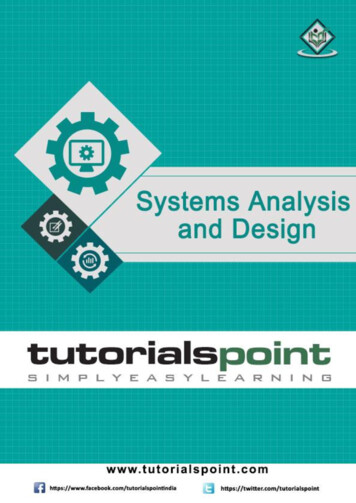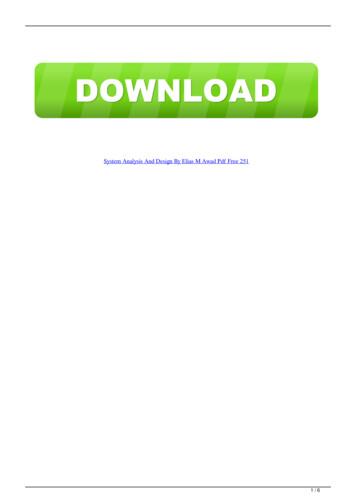
Transcription
0
Systems Analysis and DesignAbout the TutorialSystems Analysis and Design is an active field in which analysts repetitively learn newapproaches and different techniques for building the system more effectively andefficiently. The primary objective of systems analysis and design is to improveorganizational systems.This tutorial provides a basic understanding of system characteristics, system design, andits development processes. It is a good introductory guide that provides an overview of allthe concepts necessary to build a system.AudienceThis tutorial will help budding software professionals to understand how a system isdesigned in a systematic and phased manner, starting from requirement analysis tosystem implementation and maintenance.PrerequisitesThis tutorial is designed for absolute beginners and hence there are no prerequisites assuch, however it is assumed that the reader is familiar with the fundamentals ofcomputers.Disclaimer & Copyright Copyright 2018 by Tutorials Point (I) Pvt. Ltd.All the content and graphics published in this e-book are the property of Tutorials Point (I)Pvt. Ltd. The user of this e-book is prohibited to reuse, retain, copy, distribute, or republishany contents or a part of contents of this e-book in any manner without written consentof the publisher.We strive to update the contents of our website and tutorials as timely and as precisely aspossible, however, the contents may contain inaccuracies or errors. Tutorials Point (I) Pvt.Ltd. provides no guarantee regarding the accuracy, timeliness, or completeness of ourwebsite or its contents including this tutorial. If you discover any errors on our website orin this tutorial, please notify us at contact@tutorialspoint.comi
Systems Analysis and DesignTable of ContentsAbout the Tutorial . iAudience . iPrerequisites . iDisclaimer & Copyright . iTable of Contents . ii1.SYSTEMS ANALYSIS AND DESIGN OVERVIEW. 1Systems Analysis . 1Systems Design . 1What is a System? . 1Properties of a System . 2Elements of a System . 3Types of Systems . 4Systems Models. 6Categories of Information . 72.SYSTEMS ANALYSIS AND DESIGN SYSTEM DEVELOPMENT LIFE CYCLE . 8Phases of SDLC . 8Life Cycle of System Analysis and Design . 11Role of System Analyst . 11Attributes of a Systems Analyst . 123.SYSTEMS ANALYSIS AND DESIGN SYSTEM PLANNING. 14What is Requirements Determination? . 14Major Activities in requirement Determination . 14Information Gathering Techniques . 14Feasibility Study . 17ii
Systems Analysis and DesignSteps Involved in Feasibility Analysis . 18Types of Feasibilities. 184.SYSTEMS ANALYSIS AND DESIGN STRUCTURED ANALYSIS . 20What is Structured Analysis? . 20Structured Analysis Tools . 20Data Flow Diagrams (DFD) or Bubble Chart . 21Data Dictionary . 23Decision Trees . 23Decision Tables . 24Structured English . 25Pseudocode . 26Guidelines for Selecting Appropriate Tools . 265.SYSTEMS ANALYSIS AND DESIGN SYSTEM DESIGN . 28Inputs to System Design . 28Outputs for System Design . 29Types of System Design . 29File Organization . 31File Access . 32Documentation Control . 33Types of Documentations . 34User Documentation . 34System Documentation . 356.SYSTEMS ANALYSIS AND DESIGN DESIGN STRATEGIES . 36Top-Down Strategy . 36Bottom-Up Strategy . 36iii
Systems Analysis and DesignStructured Design . 37Factors Affecting System Complexity . 397.SYSTEMS ANALYSIS AND DESIGN INPUT / OUTPUT & FORMS DESIGN. 42Input Design . 42Output Design . 43Forms Design . 448.SYSTEMS ANALYSIS AND DESIGN TESTING AND QUALITY ASSURANCE . 46Testing . 46Types of Testing. 47Rules for System Testing . 48Quality Assurance . 489.SYSTEMS ANALYSIS AND DESIGN SYSTEM IMPLEMENTATION AND MAINTENANCE . 50Training . 50Training Methods . 51Conversion . 51System Maintenance / Enhancement . 5410.SYSTEMS ANALYSIS AND DESIGN SYSTEM SECURITY AND AUDIT . 55System Audit . 55Audit of Computer System Usage . 55Audit Trial . 55Audit Methods . 55Audit Considerations . 56Security . 56Control Measures . 56Risk Analysis . 57iv
Systems Analysis and Design11.SYSTEMS ANALYSIS AND DESIGN OBJECT-ORIENTED APPROACH . 59Elements of Object-Oriented System . 59Features of Object-Oriented System . 60Structured Approach Vs. Object-Oriented Approach . 61Unified Modeling Language (UML) . 61Operations Performed on Objects . 63Uses of UML . 63Static Models . 63Dynamic Models . 63Object Oriented System Development Life Cycle . 64Object Oriented Systems Development Activities . 64v
Analysis and Design1. Systems Analysis and DesignSystems OverviewSystems development is systematic process which includes phases such as planning,analysis, design, deployment, and maintenance. Here, in this tutorial, we will primarilyfocus on: Systems analysis Systems designSystems AnalysisIt is a process of collecting and interpreting facts, identifying the problems, anddecomposition of a system into its components.System analysis is conducted for the purpose of studying a system or its parts in order toidentify its objectives. It is a problem solving technique that improves the system andensures that all the components of the system work efficiently to accomplish their purpose.Analysis specifies what the system should do.Systems DesignIt is a process of planning a new business system or replacing an existing system bydefining its components or modules to satisfy the specific requirements. Before planning,you need to understand the old system thoroughly and determine how computers can bestbe used in order to operate efficiently.System Design focuses on how to accomplish the objective of the system.System Analysis and Design (SAD) mainly focuses on: SystemsProcessesTechnologyWhat is a System?The word System is derived from Greek word Systema, which means an organizedrelationship between any set of components to achieve some common cause or objective.A system is “an orderly grouping of interdependent components linked together accordingto a plan to achieve a specific goal.”Constraints of a SystemA system must have three basic constraints:1. A system must have some structure and behavior which is designed to achievea predefined objective.6
Systems Analysis and Design2. existamongthesystem3. The objectives of the organization have a higher priority than the objectivesof its subsystems.For example, traffic management system, payroll system, automatic library system,human resources information system.Properties of a SystemA system has the following properties:OrganizationOrganization implies structure and order. It is the arrangement of components that helpsto achieve predetermined objectives.InteractionIt is defined by the manner in which the components operate with each other.For example, in an organization, purchasing department must interact with productiondepartment and payroll with personnel department.InterdependenceInterdependence means how the components of a system depend on one another. Forproper functioning, the components are coordinated and linked together according to aspecified plan. The output of one subsystem is the required by other subsystem as input.IntegrationIntegration is concerned with how a system components are connected together. It meansthat the parts of the system work together within the system even if each part performsa unique function.Central ObjectiveThe objective of system must be central. It may be real or stated. It is not uncommon foran organization to state an objective and operate to achieve another.The users must know the main objective of a computer application early in the analysisfor a successful design and conversion.7
Systems Analysis and DesignElements of a SystemThe following diagram shows the elements of a system:Outputs and Inputs The main aim of a system is to produce an output which is useful for its user. Inputs are the information that enters into the system for processing. Output is the outcome of processing.Processor(s) The processor is the element of a system that involves the actual transformationof input into output. It is the operational component of a system. Processors may modify the input eithertotally or partially, depending on the output specification. As the output specifications change, so does the processing. In some cases, inputis also modified to enable the processor for handling the transformation.Control The control element guides the system. It is the decision–making subsystem that controls the pattern of activitiesgoverning input, processing, and output.8
Systems Analysis and Design The behavior of a computer System is controlled by the Operating System andsoftware. In order to keep system in balance, what and how much input is neededis determined by Output Specifications.Feedback Feedback provides the control in a dynamic system. Positive feedback is routine in nature that encourages the performance of thesystem. Negative feedback is informational in nature that provides the controller withinformation for action.Environment The environment is the “supersystem” within which an organization operates. It is the source of external elements that strike on the system. It determines how a system must function. For example, vendors and competitorsof organization’s environment, may provide constraints that affect the actualperformance of the business.Boundaries and Interface A system should be defined by its boundaries. Boundaries are the limits thatidentify its components, processes, and interrelationship when it interfaces withanother system. Each system has boundaries that determine its sphere of influence and control. The knowledge of the boundaries of a given system is crucial in determining thenature of its interface with other systems for successful design.Types of SystemsThe systems can be divided into the following types:Physical or Abstract Systems Physical systems are tangible entities. We can touch and feel them. Physical System may be static or dynamic in nature. For example, desks and chairsare the physical parts of computer center which are static. A programmed computeris a dynamic system in which programs, data, and applications can changeaccording to the user's needs. Abstract systems are non-physical entities or conceptual that may be formulas,representation or model of a real system.Open or Closed Systems9
Systems Analysis and Design An open system must interact with its environment. It receives inputs from anddelivers outputs to the outside of the system. For example, an information systemwhich must adapt to the changing environmental conditions. A closed system does not interact with its environment. It is isolated fromenvironmental influences. A completely closed system is rare in reality.Adaptive and Non Adaptive System Adaptive System responds to the change in the environment in a way to improvetheir performance and to survive. For example, human beings, animals. Non Adaptive System is the system which does not respond to the environment.For example, machines.Permanent or Temporary System Permanent System persists for long time. For example, business policies. Temporary System is made for specified time and after that they are demolished.For example, A DJ system is set up for a program and it is dissembled after theprogram.Natural and Manufactured System Natural systems are created by the nature. For example, Solar system, seasonalsystem. Manufactured System is the man-made system. For example, Rockets, dams,trains.Deterministic or Probabilistic System Deterministic system operates in a predictable manner and the interaction betweensystem components is known with certainty. For example, two molecules ofhydrogen and one molecule of oxygen makes water. Probabilistic System shows uncertain behavior. The exact output is not known. Forexample, Weather forecasting, mail delivery.Social, Human-Machine, Machine System Social System is made up of people. For example, social clubs, societies. In Human-Machine System, both human and machines are involved to perform aparticular task. For example, Computer programming. Machine System is where human interference is neglected. All the tasks areperformed by the machine. For example, an autonomous robot.Man–Made Information Systems10
Systems Analysis and Design It is an interconnected set of information resources to manage data for particularorganization, under Direct Management Control (DMC).This system includes hardware, software, communication, data, and application forproducing information according to the need of an organization.Man-made information systems are divided into three types: Formal Information System: It is based on the flow of information in the formof memos, instructions, etc., from top level to lower levels of management. Informal Information System: This is employee based system which solves theday to day work related problems. Computer Based System: This system is directly dependent on the computer formanaging business applications. For example, automatic library system, railwayreservation system, banking system, etc.Systems ModelsSchematic Models A schematic model is a 2-D chart that shows system elements and their linkages. Different arrows are used to show information flow, material flow, and informationfeedback.Flow System Models A flow system model shows the orderly flow of the material, energy, andinformation that hold the system together. Program Evaluation and Review Technique (PERT), for example, is used to abstracta real world system in model form.Static System Models They represent one pair of relationships such as activity–time or cost–quantity. The Gantt chart, for example, gives a static picture of an activity-time relationship.Dynamic System Models Business organizations are dynamic systems. A dynamic model approximates thetype of organization or application that analysts deal with. It shows an ongoing, constantly changing status of the system. It consists of:a) Inputs that enter the systemb) The processor through which transformation takes placec) The program(s) required for processingd) The output(s) that result from processing.11
Systems Analysis and DesignCategories of InformationThere are three categories of information related to managerial levels and the decisionmanagers make.Strategic Information This information is required by topmost management for long range planningpolicies for next few years. For example, trends in revenues, financial investment,and human resources, and population growth. This type of information is achieved with the aid of Decision Support System (DSS).Managerial Information This type of Information is required by middle management for short andintermediate range planning which is in terms of months. For example, salesanalysis, cash flow projection, and annual financial statements. It is achieved with the aid of Management Information Systems (MIS).12
Systems Analysis and DesignOperational information This type of information is required by low management for daily and short term planning to enforce day-to-day operational activities.For example, keeping employee attendance records, overdue purchase orders, andcurrent stocks available.It is achieved with the aid of Data Processing Systems (DPS).13
Systems Analysis and DesignEnd of ebook previewIf you liked what you saw Buy it from our store @ https://store.tutorialspoint.com14
Systems Analysis and Design 7 2. Interconnectivity and interdependence must exist among the system components. 3. The objectives of the organization have a higher priority than the objectives of its subsystems. For example, traffic management system, payroll system, automatic library system, human resources information system. Properties of a System










